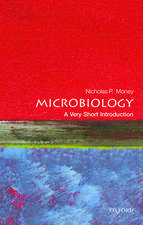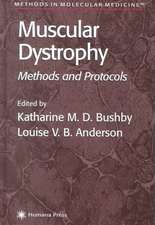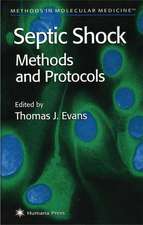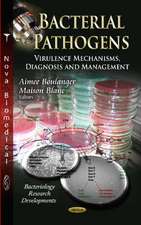Human Retrovirus Protocols: Virology and Molecular Biology: Methods in Molecular Biology, cartea 304
Editat de Tuofu Zhuen Limba Engleză Hardback – 17 mai 2005
| Toate formatele și edițiile | Preț | Express |
|---|---|---|
| Paperback (1) | 955.70 lei 6-8 săpt. | |
| Humana Press Inc. – 19 noi 2010 | 955.70 lei 6-8 săpt. | |
| Hardback (1) | 962.81 lei 6-8 săpt. | |
| Humana Press Inc. – 17 mai 2005 | 962.81 lei 6-8 săpt. |
Din seria Methods in Molecular Biology
- 9%
 Preț: 791.63 lei
Preț: 791.63 lei - 23%
 Preț: 598.58 lei
Preț: 598.58 lei - 20%
 Preț: 882.98 lei
Preț: 882.98 lei -
 Preț: 252.05 lei
Preț: 252.05 lei - 5%
 Preț: 802.70 lei
Preț: 802.70 lei - 5%
 Preț: 729.61 lei
Preț: 729.61 lei - 5%
 Preț: 731.43 lei
Preț: 731.43 lei - 5%
 Preț: 741.30 lei
Preț: 741.30 lei - 5%
 Preț: 747.16 lei
Preț: 747.16 lei - 15%
 Preț: 663.45 lei
Preț: 663.45 lei - 18%
 Preț: 1025.34 lei
Preț: 1025.34 lei - 5%
 Preț: 734.57 lei
Preț: 734.57 lei - 18%
 Preț: 914.20 lei
Preț: 914.20 lei - 15%
 Preț: 664.61 lei
Preț: 664.61 lei - 15%
 Preț: 654.12 lei
Preț: 654.12 lei - 18%
 Preț: 1414.74 lei
Preț: 1414.74 lei - 5%
 Preț: 742.60 lei
Preț: 742.60 lei - 20%
 Preț: 821.65 lei
Preț: 821.65 lei - 18%
 Preț: 972.30 lei
Preț: 972.30 lei - 15%
 Preț: 660.49 lei
Preț: 660.49 lei - 5%
 Preț: 738.41 lei
Preț: 738.41 lei - 18%
 Preț: 984.92 lei
Preț: 984.92 lei - 5%
 Preț: 733.29 lei
Preț: 733.29 lei -
 Preț: 392.60 lei
Preț: 392.60 lei - 5%
 Preț: 746.26 lei
Preț: 746.26 lei - 18%
 Preț: 962.66 lei
Preț: 962.66 lei - 23%
 Preț: 860.22 lei
Preț: 860.22 lei - 15%
 Preț: 652.64 lei
Preț: 652.64 lei - 5%
 Preț: 1055.50 lei
Preț: 1055.50 lei - 23%
 Preț: 883.87 lei
Preț: 883.87 lei - 19%
 Preț: 491.89 lei
Preț: 491.89 lei - 5%
 Preț: 1038.86 lei
Preț: 1038.86 lei - 5%
 Preț: 524.16 lei
Preț: 524.16 lei - 18%
 Preț: 2122.34 lei
Preț: 2122.34 lei - 5%
 Preț: 1299.23 lei
Preț: 1299.23 lei - 5%
 Preț: 1339.12 lei
Preț: 1339.12 lei - 18%
 Preț: 1390.26 lei
Preț: 1390.26 lei - 18%
 Preț: 1395.63 lei
Preț: 1395.63 lei - 18%
 Preț: 1129.65 lei
Preț: 1129.65 lei - 18%
 Preț: 1408.26 lei
Preț: 1408.26 lei - 18%
 Preț: 1124.92 lei
Preț: 1124.92 lei - 18%
 Preț: 966.27 lei
Preț: 966.27 lei - 5%
 Preț: 1299.99 lei
Preț: 1299.99 lei - 5%
 Preț: 1108.51 lei
Preț: 1108.51 lei - 5%
 Preț: 983.76 lei
Preț: 983.76 lei - 5%
 Preț: 728.16 lei
Preț: 728.16 lei - 18%
 Preț: 1118.62 lei
Preț: 1118.62 lei - 18%
 Preț: 955.25 lei
Preț: 955.25 lei - 5%
 Preț: 1035.62 lei
Preț: 1035.62 lei - 18%
 Preț: 1400.35 lei
Preț: 1400.35 lei
Preț: 962.81 lei
Preț vechi: 1174.15 lei
-18% Nou
Puncte Express: 1444
Preț estimativ în valută:
184.26€ • 191.66$ • 152.11£
184.26€ • 191.66$ • 152.11£
Carte tipărită la comandă
Livrare economică 12-26 aprilie
Preluare comenzi: 021 569.72.76
Specificații
ISBN-13: 9781588294951
ISBN-10: 1588294951
Pagini: 494
Ilustrații: XIV, 494 p.
Dimensiuni: 155 x 235 x 33 mm
Greutate: 0.94 kg
Ediția:2005
Editura: Humana Press Inc.
Colecția Humana
Seria Methods in Molecular Biology
Locul publicării:Totowa, NJ, United States
ISBN-10: 1588294951
Pagini: 494
Ilustrații: XIV, 494 p.
Dimensiuni: 155 x 235 x 33 mm
Greutate: 0.94 kg
Ediția:2005
Editura: Humana Press Inc.
Colecția Humana
Seria Methods in Molecular Biology
Locul publicării:Totowa, NJ, United States
Public țintă
Professional/practitionerCuprins
Methods for Virus Isolation and Detection.- Enhanced Culture Assay for Detection and Quantitation of Latently Infected, Resting CD4+ T-Cells Carrying Replication-Competent Virus in HIV-1-Infected Individuals.- Isolation, Propagation, and Titration of Human Immunodeficiency Virus Type 1 From Peripheral Blood of Infected Individuals.- Isolation of Human Immunodeficiency Virus Type 1 From Peripheral Blood Monocytes.- Isolation, Propagation, and HIV-1 Infection of Monocyte-Derived Macrophages and Recovery of Virus From Brain and Cerebrospinal Fluid.- Isolation and HIV-1 Infection of Primary Human Microglia From Fetal and Adult Tissue.- Isolation of Human Immunodeficiency Virus Type 1 From Semen and Vaginal Fluids.- Isolation and Quantification of HIV From Lymph Nodes.- Isolation of Human Immunodeficiency Virus Type 2 Biological Clones From Peripheral Blood Lymphocytes.- Isolation and Confirmation of Human T-Cell Leukemia Virus Type 2 From Peripheral Blood Mononuclear Cells.- Isolation of Foamy Viruses From Peripheral Blood Lymphocytes.- Alu-LTR Real-Time Nested PCR Assay for Quantifying Integrated HIV-1 DNA.- Quantification of HFV-Integrated DNA in Human Cells by Alu-LTR Real-Time PCR.- Detection of HIV-1 Provirus and RNA by In Situ Amplification.- Detection of HTLV-1 Gene on Cytologic Smear Slides.- Detection of HIV-2 by PCR.- Quantitation of HIV-1 Viral RNA in Blood Plasma and Genital Secretions.- Quantification of Proviral DNA Load of Human Immunodeficiency Virus Type 2 Subtypes A and B Using Real-Time PCR.- Plasma RNA Viral Load in HIV-1 Group O Infection by Real-Time PCR.- A New Combined HIV p24 Antigen and Anti-HIV-1/2/O Screening Assay.- A New Automated Fourth-Generation HIV Screening Assay With Sensitive Antigen Detection Module and High Specificity.- Detection of Antiviral Antibodies Using Enzyme-Linked Immunosorbent Assay.- Plaque-Reduction Assays for Human and Simian Immunodeficiency Virus Neutralization.- Detection of Drug-Resistant HIV-1 Strains.- Molecular Biology Methods.- Determination of Cell Tropism of HIV-1.- Determination of Co-Receptor Usage of HIV-1.- Quantitative Evaluation of HIV and SIV Co-Receptor Use With GHOST(3) Cell Assay.- Phenotypic Characterization of Blood Monocytes From HIV-Infected Individuals.- Methods to Determine HIV-1 Ex Vivo Fitness.- A Yeast Recombination-Based Cloning System to Produce Chimeric HIV-1 Viruses and Express HIV-1 Genes.- PCR Amplification, Cloning, and Construction of HIV-1 Infectious Molecular Clones From Virtually Full-Length HIV-1 Genomes.- Amplification and Cloning of Near Full-Length HIV-2 Genomes.- Growth and Manipulation of a Human T-Cell Leukemia Virus Type 2 Full-Length Molecular Clone.- Construction and Analysis of Genomic, Full-Length Infectious Foamy Virus DNA Clones.- Molecular Characterization of Proteolytic Processing of the Gag Proteins of Human Spumaretrovirus.- Assessing the Relative Efficacy of Antiretroviral Activity of Different Drugs on Macrophages.- Gene Expression Profiling of HIV-1 Infection Using cDNA Microarrays.- Determination of DC-SIGN and DC-SIGNR Repeat Region Variations.
Recenzii
"More than 20 years after the discoveries of HTLV and HIV, there appears to be a need for a consolidated reference of many of the standard and not-so-standard protocols used to characterize the human retroviruses. This book, containing some 37 detailed protocols provided by multinational authors in two parts, does an admirable job. Part I, therefore, includes guidance on isolation of HTLV, HIV and Human Foamy Virus (HFV) from peripheral blood, lymph nodes, CNS tissue and genital secretions (semen, vaginal fluids). It also describes a variety of molecular methods (largely PCR-based) to assess viral levels, integration status and drug sensitivity, plus quantification by antigen detection. At some 313 pages, Part I forms the substantial portion of the book. Part II (168 pages) guides on assessing cell and receptor tropism, construction and utilization of molecular clones and also use of microarrays to look at host and viral gene expression. The book on the whole is well illustrated with clear photographs and diagrams to support the detailed methodology, and the references at the end of each protocol are comprehensive. "-SGM Quarterly
Textul de pe ultima copertă
Advances in our understanding of human retroviruses have been occurring at a very rapid pace and have contributed significantly to the development of new biotechnologies. In Human Retrovirus Protocols: Virology and Molecular Biology, recognized international researchers describe in detail the basic and state-of-the-art methods they have optimized for investigating the molecular biology of this class of retrovirus. These readily reproducible techniques range from proven methods for the isolation and detection of human retroviruses to advanced methods for exploring the interplay between the viruses and the host. Here, the researcher will find up-to-date techniques for the isolation and propagation of HIV, HTLV, and foamy virus from peripheral blood mononuclear cells (PBMC), blood monocytes, brain tissues, cerebrospinal fluids, semen, the vagina, and lymph nodes. There are also assays for determining the cell tropism of HIV-1, the coreceptor usage of HIV-1, and human gene expression with HIV-1 infection by microarrays, as well as for phenotyping HIV-1 infected monocytes and examining their fitness. Highlights include the detection and quantification of HIV-1 in resting CD4+, a new cloning system for making recombinant virus, cDNA microarrays, and the determination of genetic polymorphisms in two recently identified HIV-1 co-factors that are critical for HIV-1 infection. The protocols follow the highly praised Methods in Molecular Biology™ series format, each offering step-by-step laboratory instructions, an introduction outlining the principle behind the technique, lists of the necessary equipment and reagents, and tips on troubleshooting and avoiding known pitfalls.
State-of-the-art and highly practical, Human Retrovirus Protocols: Virology and Molecular Biology offers novice and experienced researchers alike proven tools essential for productive study and understanding of the human retroviruses.
State-of-the-art and highly practical, Human Retrovirus Protocols: Virology and Molecular Biology offers novice and experienced researchers alike proven tools essential for productive study and understanding of the human retroviruses.
Caracteristici
Includes supplementary material: sn.pub/extras
















